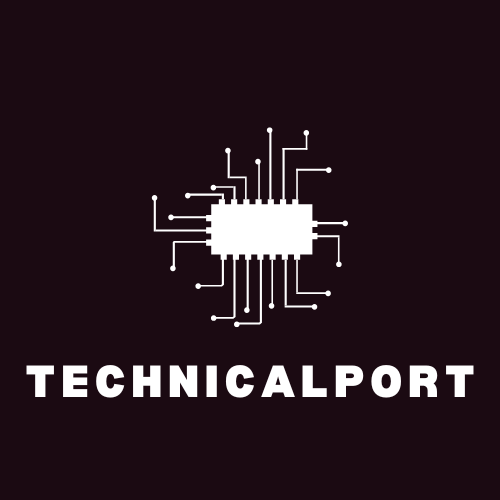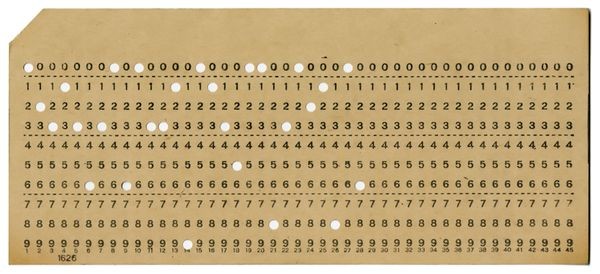
Punch card
Punch cards were a type of data storage and processing technology that was widely used in the early days of computing. They were first invented in the 17th century for use in looms, and were later adapted for use in computers. Punch cards were made of stiff cardboard or paper, and had rows of holes punched into them in a standardized pattern. The holes represented binary data, with a hole representing a “1” and the absence of a hole representing a “0”.
Punch cards were commonly used in early computers for storing and processing data. The cards were fed into a card reader, which would read the data encoded in the holes and transfer it to the computer’s memory for processing. Punch cards were also used for inputting instructions to the computer, which would then be executed by the computer’s processing unit.
Punch card working

Here are the basic steps involved in using punch cards for data storage and processing:
- Create the punch card: Cards were typically created using a punch card writer, which was a device that had a keyboard and a set of punch mechanisms. To create a punch card, the user would enter the data or instructions that they wanted to store on the card using the keyboard, and the punch mechanisms would punch holes into the card in the appropriate locations to represent the data.
- Feed the punch card into the card reader: Once the punch card was created, it would be fed into the card reader, which was a device that could read the data encoded in the holes on the card. The card reader would use a set of sensors to detect the presence or absence of holes on the card, and would convert this information into a form that the computer could understand.
- Transfer the data to the computer’s memory: Once the data on the punch card was read by the card reader, it would be transferred to the computer’s memory for processing. The computer’s memory would typically be organized into a series of storage locations, each of which could hold a single piece of data. The data from the card would be placed into the appropriate storage locations in the computer’s memory.
- Process the data: Once the data from the punch card was transferred to the computer’s memory, it would be processed by the computer’s processing unit. This would typically involve executing instructions that were encoded on the punch card, such as calculations or comparisons. The results of the processing would be stored in the computer’s memory, and could be used for further processing or output.
- Output the results: Once the data on the card was processed by the computer, the results could be output in various forms, such as on a display screen or on a printer. The results could also be stored on another punch card for further processing or archival purposes.
These are the basic steps involved in using punch cards for data storage and processing. These cards were a key technology in the early days of computing, and although they have now been replaced by more advanced technologies & new concept like Quantum computing are introduced but, they remain an important part of the history of computing.
Machines that uses punch card
Punch cards were commonly used in a wide range of early computers, from large mainframe computers to smaller, more specialized systems. Some of the most well-known computers that used punch cards include the IBM 700 series, the UNIVAC I, and the ENIAC.
The IBM 700 series was a line of mainframe computers that was developed by IBM in the 1950s and 1960s. These computers used punch cards as their primary means of data storage and input, and they were widely used in a variety of applications, such as scientific research, business data processing, and government administration.
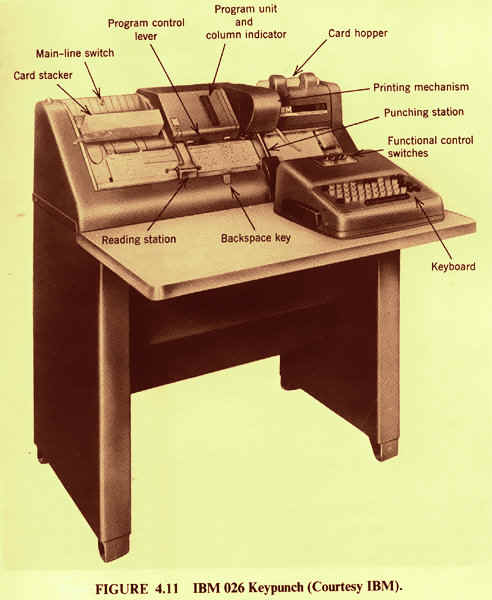
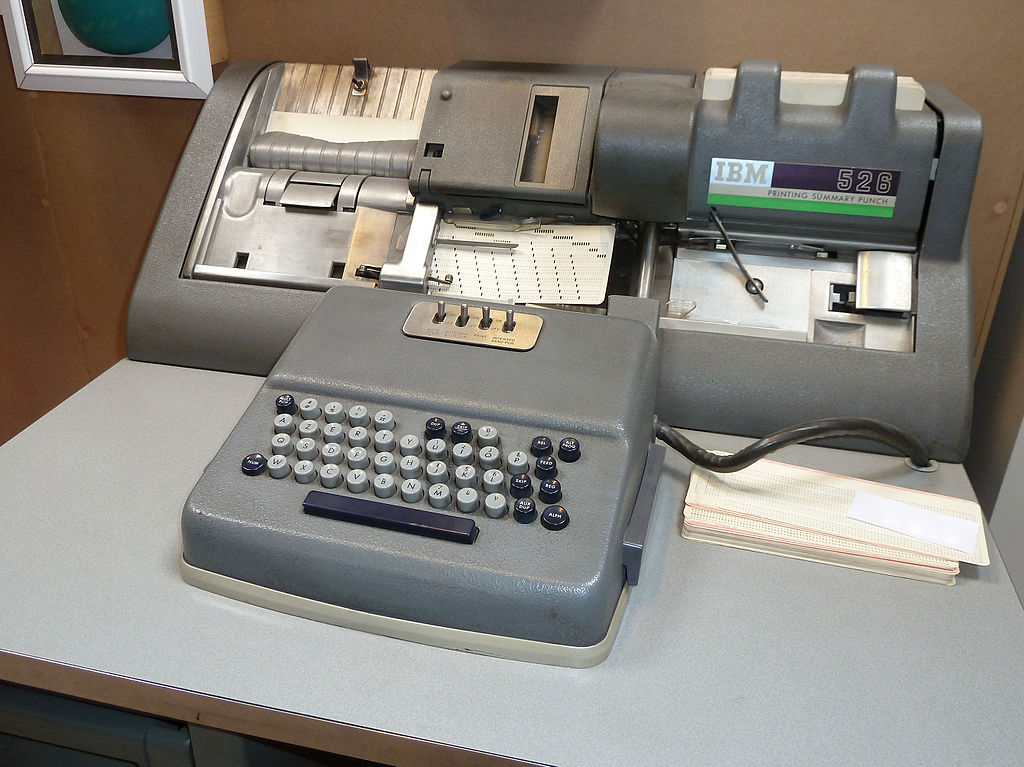
The UNIVAC I (Universal Automatic Computer I) was one of the first commercial computers to be developed in the United States. It was introduced in 1951 and used punch cards as its primary means of data storage and input. The UNIVAC I was used by a number of government agencies and businesses for a variety of applications, such as data processing and analysis.
The ENIAC (Electronic Numerical Integrator And Computer) was one of the first general-purpose electronic computers to be developed. It was completed in 1945 and used punch cards as its primary means of input and output. The ENIAC was used for a variety of scientific and military applications, and it paved the way for the development of more advanced computers in the years that followed.
ASCII punching
ASCII punching is the process of using a punch card or other mechanical device to represent characters and symbols in the ASCII code. In the early days of computing, punch cards were commonly used as a means of storing and inputting data, and the ASCII code was a widely used standard for representing characters and symbols in a digital format.
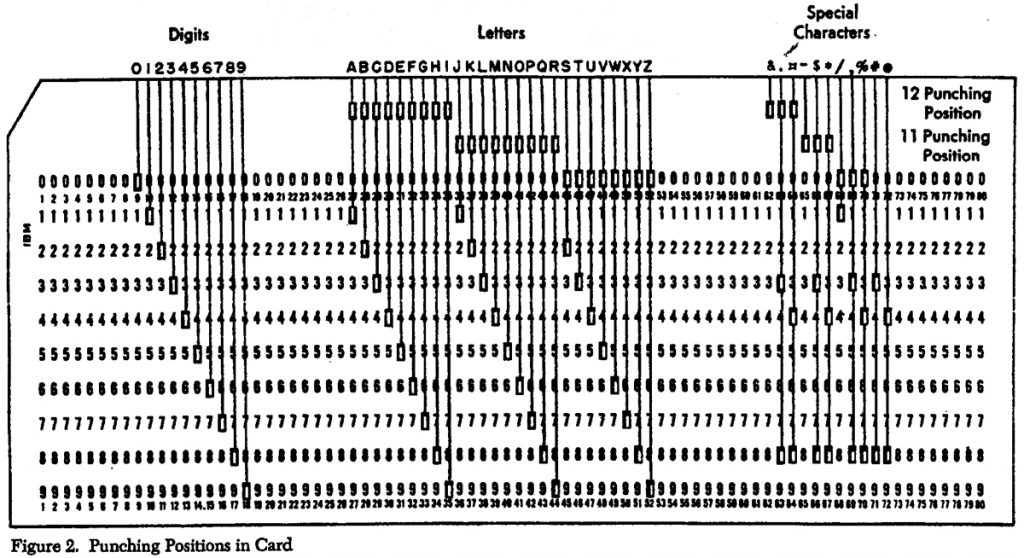
To perform ASCII punching, a user would use a punch card writer, which was a device that had a keyboard and a set of punch mechanisms. The user would enter the characters or symbols that they wanted to represent on the card using the keyboard, and the punch mechanisms would punch holes into the card in the appropriate locations to represent the ASCII code for the characters or symbols.
Once the punch card was created, it could be fed into a card reader, which would read the data encoded in the holes on the card and transfer it to the computer’s memory for processing. The computer would then be able to interpret the data on the card and use it for various purposes, such as data processing or output.
The ASCII code is a standardized system for representing characters and symbols in a digital format. Each character or symbol is represented by a unique code, which is made up of a series of bits. In the original ASCII code, which was developed in the 1960s, each code was made up of 7 bits. This allowed for a total of 128 different codes, which were sufficient to represent the upper- and lower-case letters of the English alphabet, as well as numbers, punctuation marks, and other commonly used symbols.
However, in some cases, it may be necessary to use a smaller number of bits to represent the ASCII code. For example, if a system is limited to using 6 bits for each code, it would be possible to represent 64 different codes using the ASCII code. This would be sufficient to represent the upper-case letters of the English alphabet, as well as numbers and some punctuation marks. However, it would not be possible to represent the lower-case letters, as there are more than 64 of them.
In summary, the ASCII code typically uses 7 bits to represent each character or symbol. However, it is possible to use a smaller number of bits, such as 6 bits, if necessary. This would reduce the number of different codes that can be represented, but would still allow for the representation of a limited set of characters and symbols.
ASCII punching was a key technology in the early days of computing, and it played a crucial role in the development of the digital economy. Although it has now been largely replaced by more advanced technologies, it remains an important part of the history of computing.
ALGOL in Punch card
ALGOL (short for “Algorithmic Language”) was a programming language that was developed in the 1950s and 1960s. It was one of the first high-level programming languages to be developed, and it was designed to be more readable and easier to use than the low-level languages that were commonly used at the time.
In the early days of computing, punch cards were commonly used as a means of storing and inputting data, and they were also used to represent programs written in programming languages such as ALGOL. To represent an ALGOL program on a punch card, the program would first be written using a text editor or other suitable tool. The program would then be compiled, which is the process of converting the human-readable code into machine-readable instructions.
Once the program was compiled, it would be represented on a punch card using the ASCII code or another suitable code. The punch card would then be fed into a card reader, which would read the data encoded in the holes on the card and transfer it to the computer’s memory for processing. The computer would then be able to execute the instructions encoded on the punch card, and the results of the program would be output in various forms, such as on a display screen or on a printer.
In summary, punch cards were commonly used to represent ALGOL programs in the early days of computing. The programs would be written and compiled using appropriate tools, and then represented on punch cards using a suitable code. The punch cards would then be fed into a card reader, which would transfer the data to the computer’s memory for processing.
ICL 1900 series
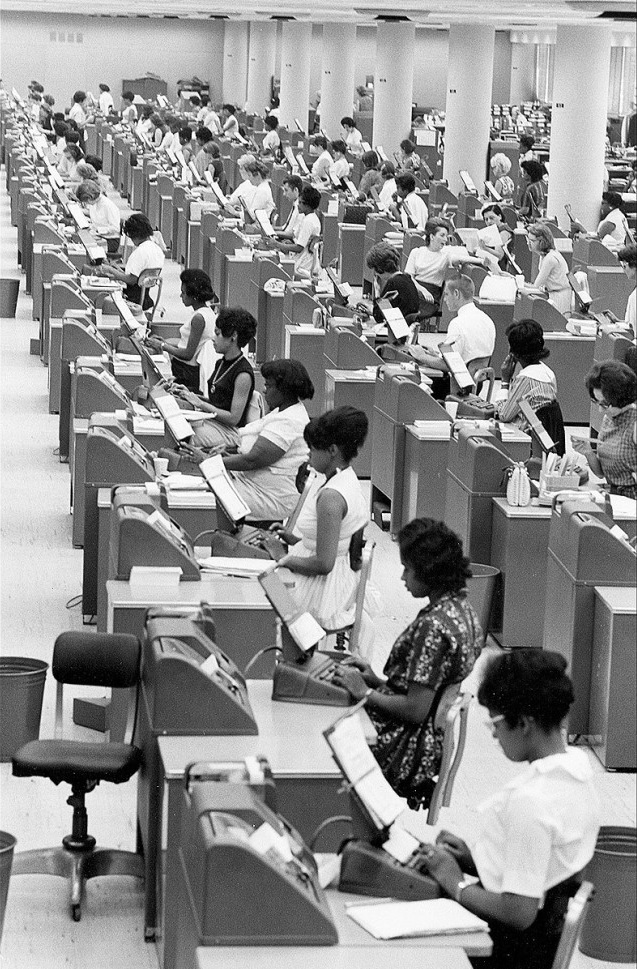
The ICL 1900 series was a line of mainframe computers that was developed by the International Computers and Tabulators (ICT) company in the 1960s and 1970s. The 1900 series was designed to be a high-performance, reliable, and cost-effective alternative to other mainframe computers of the time, such as the IBM System/360.
In terms of character representation, the 1900 series used the ASCII code, which is a standardized system for representing characters and symbols in a digital format. In the original ASCII code, which was developed in the 1960s, each character or symbol was represented using 7 bits. This allowed for a total of 128 different codes, which were sufficient to represent the upper- and lower-case letters of the English alphabet, as well as numbers, punctuation marks, and other commonly used symbols.
However, it is possible that the 1900 series computers may have used a different configuration of bits to represent characters. For example, if the 1900 series computers used 6 bits to represent each character, it would be possible to represent 64 different codes using the ASCII code. This would be sufficient to represent the upper-case letters of the English alphabet, as well as numbers and some punctuation marks. However, it would not be possible to represent the lower-case letters, as there are more than 64 of them.
In summary, the ICL 1900 series computers likely used the ASCII code to represent characters and symbols, but it is possible that they used a different configuration of bits than the standard 7-bit ASCII code
6 bit adder circuitry vs 8 bit adder circuitry
A bit adder is a digital circuit that is used to add two binary numbers together. Binary numbers are numbers that are represented using the binary numeral system, which uses only two digits, “0” and “1”, to represent all possible numeric values. In a bit adder circuit, the two binary numbers to be added are input to the circuit, and the circuit produces an output that is the sum of the two input numbers.
The difference between a 6-bit adder and an 8-bit adder lies in the number of bits that the adder is capable of handling at once. A 6-bit adder can only add two binary numbers that are 6 bits in length each, while an 8-bit adder can add two binary numbers that are 8 bits in length each. This means that an 8-bit adder has a greater range of possible input values and a larger output value than a 6-bit adder.
In terms of circuitry, the design of a 6-bit adder and an 8-bit adder will be similar, but the 8-bit adder will have more components and will be more complex. Both adders will use logic gates, such as AND gates and XOR gates, to perform the addition operation, but the 8-bit adder will have more gates and will require more wiring to connect them together.
Overall, the main difference between a 6-bit adder and an 8-bit adder is the number of bits that they can handle at once. An 8-bit adder has a greater range of input values and a larger output value than a 6-bit adder, but it is also more complex and requires more circuitry to implement.
ICL George operating system used for Punch cards
ICL George was a real-time operating system (OS) that was developed by the International Computers and Tabulators (ICT) company in the 1960s and 1970s. It was designed for use on the ICL 1900 series of mainframe computers, and it was one of the first real-time operating systems to be developed.
The ICL George operating system was designed to support the needs of real-time applications, which are applications that require immediate processing and response to input data. This could include applications such as air traffic control, process control, and other applications that require fast and reliable data processing.
To support real-time applications, the ICL George operating system used several key features and technologies. It had a high-speed, multi-tasking kernel that could handle multiple tasks simultaneously, and it had a flexible memory management system that allowed applications to access and manipulate data in real-time. The operating system also had support for communication between multiple computers and devices, which allowed for the development of distributed real-time applications.
Overall, the ICL George operating system was a pioneering technology in the field of real-time computing, and it paved the way for the development of many of the real-time operating systems that are used today.
Job controller in punch card
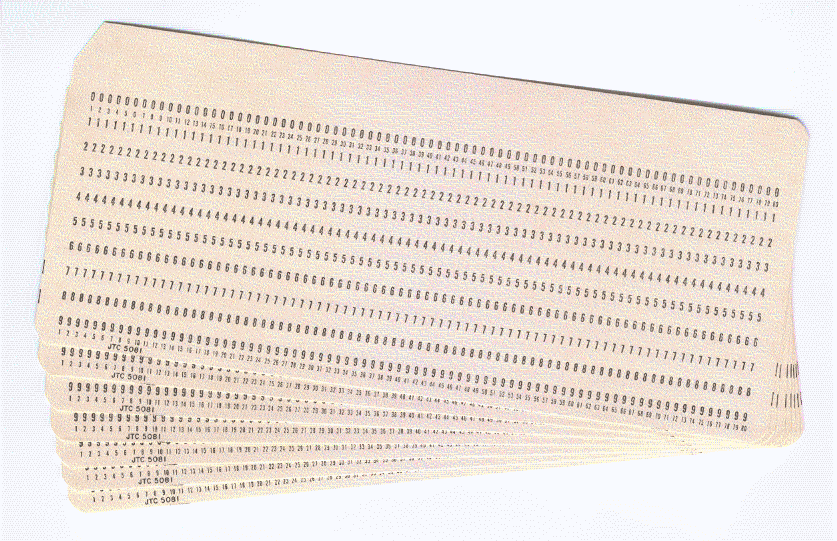
A job controller was a device that was used in early computing systems to control the execution of programs that were stored on punch cards. The job controller was typically used in conjunction with a punch card reader, which was a device that could read the data encoded in the holes on punch cards and transfer it to the computer’s memory for processing.
The job controller would typically be connected to the punch card reader, and it would monitor the data that was being transferred from the punch cards to the computer’s memory. The job controller would interpret the data on the punch cards and use it to control the execution of the program that was being input to the computer. This could include tasks such as starting and stopping the program, branching to different sections of the program, and handling input and output operations.
The job controller was an important component of early computing systems, as it allowed the computer to execute programs that were stored on punch cards in a controlled and orderly manner.
Punch cards were commonly used in the early days of computing as a means of storing and inputting data. To use punch cards, a user would typically create the cards using a punch card writer, which was a device that had a keyboard and a set of punch mechanisms. The user would enter the data or instructions that they wanted to store on the punch card using the keyboard, and the punch mechanisms would punch holes into the card in the appropriate locations to represent the data.
Once the punch card was created, it would be fed into a card reader, which was a device that could read the data encoded in the holes on the card. The card reader would use a set of sensors to detect the presence or absence of holes on the card, and would convert this information into a form that the computer could understand.
The card reader was typically controlled by a job controller, which was a program or device that managed the operation of the card reader and other input/output devices. The job controller would control the flow of data between the card reader and the computer’s memory, and would ensure that the data was processed in the correct order and according to the instructions encoded on the punch card.
Overall, the job controller was an important part of the punch card system, as it managed the flow of data between the card reader and the computer and ensured that the data was processed correctly.
ALGOL Compiler working for Punch card
To use punch cards with an ALGOL compiler, a programmer would first write their program in the ALGOL language and save it on a punch card. The punch card would then be fed into the ALGOL compiler, which would read the program from the punch card and convert it into machine code.
The machine code generated by the ALGOL compiler would then be stored on another punch card, which could be fed into the computer for execution. The computer would read the machine code from the punch card and execute it, performing the operations and calculations specified in the original ALGOL program.
Overall, the ALGOL compiler played a key role in the use of punch cards for programming in the ALGOL language. It allowed programmers to write programs in ALGOL and convert them into a form that could be executed by a computer using punch cards.
Keypunch Machine

A keypunch machine is a mechanical device that is used to create punch cards, which were a common form of data storage and input in the early days of computing. A punch card is a thin, rectangular piece of card stock that has a series of rows and columns of holes punched into it. Each hole represents a binary digit (0 or 1), and the combination of holes on the card encodes data or instructions that can be read and processed by a computer.
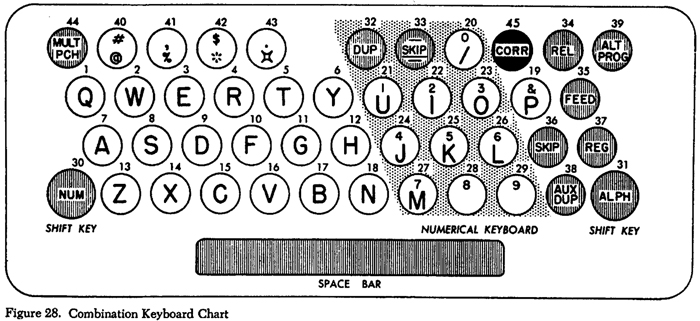
A keypunch machine is similar to a card punch machine, but it is typically smaller and more portable. It typically consists of a keyboard and a set of punch mechanisms, but it does not have the mechanism for feeding and aligning the punch cards that is found on a card punch machine. Instead, the user would manually align the punch card with the punch mechanisms, and then use the keyboard to enter the data or instructions that they wanted to store on the card. The punch mechanisms would then punch holes into the card in the appropriate locations to represent the data.

Once the punch card was created, it could be fed into a card reader, which was a device that could read the data encoded in the holes on the card. The card reader would use a set of sensors to detect the presence or absence of holes on the card, and would convert this information into a form that the computer could understand. The computer would then be able to use the data on the punch card for various purposes, such as data processing or output.
Punch card reader
- First, a punch card is created using a punch card writer or keypunch machine. The punch card writer has a keyboard and a set of punch mechanisms, and the user can use the keyboard to enter the data or instructions that they want to store on the punch card. The punch mechanisms will punch holes into the card in the appropriate locations to represent the data.
- Once the punch card is created, it is fed into the punch card reader. The punch card reader has a set of sensors that can detect the presence or absence of holes on the punch card.
- As the punch card is fed into the reader, the sensors scan the card and detect the holes in each column. The reader converts this information into a form that the computer can understand, such as a series of binary digits (0s and 1s).
- The punch card reader transfers the data from the punch card to the computer’s memory. This data can then be accessed and used by the computer for various purposes, such as data processing or output.
- The punch card reader is typically controlled by a job controller, which is a program or device that manages the operation of the reader and other input/output devices. The job controller ensures that the data on the punch card is processed in the correct order and according to the instructions encoded on the card.
Overall, the process of reading data from a punch card using a punch card reader involves several steps, including creating the punch card, feeding it into the reader, detecting the holes on the card, converting the data into a form that the computer can understand, and transferring the data to the computer’s memory for processing.
